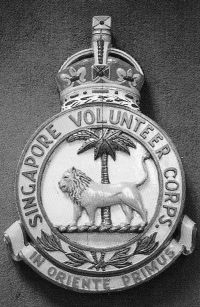Singapore Volunteer Corps facts for kids
The Singapore Volunteer Corps was a special group of volunteers. It was also called the Singapore Special Constabulary. This group started in 1854 as the Singapore Volunteer Rifle Corps. Over time, it changed its name and structure many times. In 1965, it became the People's Defence Force. This force was the start of the modern Singapore Armed Forces (SAF).
Contents
History of Singapore's Volunteer Defenders
The idea for a volunteer group to help the police first came up in 1846. This group would help keep Singapore safe. The first corps, the Singapore Volunteer Rifles Corps (SVRC), formed after big riots. These riots happened between Chinese secret societies from May 5 to 17, 1854.
The conflict caused a lot of trouble and deaths. The police needed help from the military and other groups. Even European residents and convicts helped to bring back order. More than 400 people died, and 300 houses were burned.
Because of the growing violence and the Crimean War starting, leaders decided to form a volunteer corps. This group would be made of European residents. British officers would lead them. At first, people paid for the group themselves. Members even used their own weapons.
The SVRC started on July 8, 1854. The Governor, Colonel William John Butterworth, supported it. It was one of the first official volunteer groups in the British Empire. In 1857, the Indian Government passed a law. This law put the SVRC under government control. They wore green uniforms, like the Rifle Brigade. The SVRC was closed down in December 1887. This happened because too few people were left in the group.
Singapore Volunteer Artillery Corps: New Beginnings
In February 1888, the volunteer corps started again. It was now called the Singapore Volunteer Artillery. Their motto was In Oriente Primus. This means "First in the Far East." The Singapore Artillery still uses this motto today. This group was the first in the British Empire to use the Maxim Gun. This was a new type of automatic machine-gun. The guns arrived in 1889. They were paid for by donations from the Sultan of Johor and local business people.
By 1901, the Singapore Volunteer Artillery had many different parts. So, its name changed to the Singapore Volunteer Corps (SVC). It included artillery, infantry, engineers, and rifle sections. During the First World War, the SVC helped stop the Sepoy Mutiny of 1915. Eleven volunteers died during this event. In 1922, the SVC joined the Straits Settlements Volunteer Force. They formed two battalions of this new force.
The Corps also helped defend Singapore during World War II. After the Japanese Occupation ended, the SVC started up again in 1949.
In 1954, the Straits Settlements Volunteer Force was closed. The Singapore Volunteer Corps then joined the Singapore Military Forces. The Corps helped during the Malayan Emergency. Later, during the Indonesian Confrontation, they protected important places. They guarded sites in Singapore and southern Johor from attackers.
From 1963 to 1965, the SVC was part of the Malaysian Army's reserves in Singapore.
People's Defence Force: A New Era
After Singapore became independent, a new law was passed in 1965. The SVC was then renamed the People's Defence Force. Its units became part of the Singapore Armed Forces. Many volunteer officers also joined the regular army.
Volunteers continued to help with national security. They trained part-time National Servicemen. This happened when National Service started in 1967. However, full-time National Service became required. Fewer people volunteered. So, their role became smaller. The last volunteer battalion, 101 PDF, was closed in March 1984.
Important People in the Corps
- Colonel J. E. Gabain (1948-1962) Assistant Commandant SVC
- Yusof bin Ishak, who later became the first President of Singapore (1965-1970)
- Goh Keng Swee, who served as Deputy Prime Minister (1968-1985)
- David Saul Marshall, who was Chief Minister (1955-1956)
- Othman Wok, Minister of Social Affairs (1963-1977)
- Elizabeth Choy
- William Allmond Codrington Goode, Governor of Singapore (1955, 1957–1959); Yang di-Pertuan Negara (1959)
- T. J. D. Campbell, Head, 1st Singapore Volunteer Corps, later Director, General Staff of the People's Defence Force
Connections and Alliances
 United Kingdom – Royal Artillery; Singapore Royal Artillery (Volunteers)
United Kingdom – Royal Artillery; Singapore Royal Artillery (Volunteers) United Kingdom – Royal Electrical and Mechanical Engineers; Singapore Electrical and Mechanical Engineers
United Kingdom – Royal Electrical and Mechanical Engineers; Singapore Electrical and Mechanical Engineers United Kingdom – Royal Corps of Signals; Singapore Corps of Signals (Volunteers)
United Kingdom – Royal Corps of Signals; Singapore Corps of Signals (Volunteers)
See also
- Straits Settlements Volunteer Force
- Dalforce
- SAF Volunteer Corps (SAFVC)


